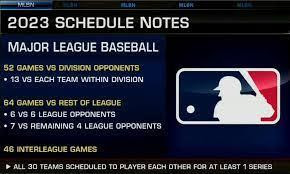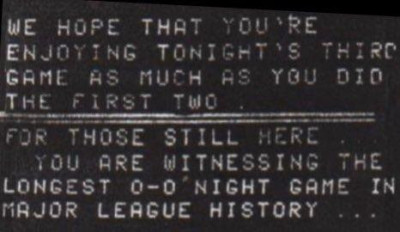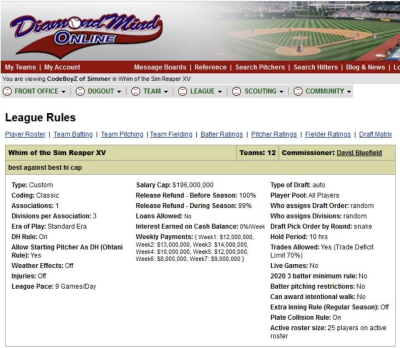NEW 24-TEAM LEAGUE SCHEDULE
We recently introduced a new 24-team league format, with two associations each comprised of three divisions of four teams. The first league to try this format – the Interleague Inaugural – is already underway.
The league schedule is not unlike that of the new MLB schedule, with every team playing every other team in both associations. The way the league schedule has been set is as follows:
- 16 games against 2 of the teams in your division (two 3-game series and one 2-game series home and away), 18 against one other (three 3-game series home and away). Total 50 games vs division opponents.
- 8 games against each of the teams in the other two divisions in your association (two 2-game series home and away). Total 64 games vs rest of association.
- 4 games against each of the teams in the other association (one 2-game series home and away). Total 48 inter-association games.
Unlike the new MLB schedule, the first and last weeks (18 games) of the season will still be played entirely against teams in your own division (three x 3-game series home and away against each other team).
Yes, two-game series, which were necessary for this format to work, are “new” to DMO and will often straddle two “real” days. But the schedule has been set in such a way that no 2-game series is split between two “real” weeks.
MAXED OUT!
The MaxScores ratings system was devised by our resident formula whiz, Larry Macdonald.
It rates team owners based on wins and losses, the strength of their opponents, and playoff success. More recent games are weighted more heavily in the system, so the rating of a team owner whose team(s) currently are “hot” or “cold” may bely their overall record.
If someone has not had an active team over the past six months – in a particular ranking category, or at all – they retain their score(s), but will not be displayed in the relevant ranking(s). Owners may also choose to exclude themselves from being listed in the rankings, although they, too, still have scores and rankings.
Here’s a shout out to our current MaxScore leaders (as at the time of writing):
• Standard – Jarred (jarreds7) Scott (.6237)
• Custom Classic – (tie) Eric (scrilla357) Duggan/Jim (villaparker) Van Derck (.6023)
• Single Season – David (dmet) Metcalf (.6718)
• Overall – Michael (brooksr) Linhoff (.6392)
David Metcalf’s SSG dominance stands out. His astounding .6718 MaxScore and .610 Win Pct far exceeds Bob (bjecmen) Jecmen’s second-ranking .6453/.588, which themselves are well above the score/win pct posted by any other team owner in any category.
RECORD-SETTING RUN OF ZEROES
On April 15, 1968, after six hours and six minutes, the Astros defeated the Mets 1-0 in 24 innings – the longest any Major League game has ever remained scoreless.
In the GOT XVII rd2 Dick Ellsworth league, Bob (bjecmen) Jecmen’s Parallel Universe and Brian (brianod) O’Donnell’s AintTheBeerCold GOT2 topped this record, playing 24 scoreless innings before AintTheBeerCold pushed a run across in the top of the 25th, only to have PU walk it off with two runs in the bottom half of the inning: Parallel Universe 2, AintTheBeerCold 1.
(IM)PERFECT
In another noteworthy GOT Round 2 encounter, in the GOT XVII rd2 Maury Wills league, Bill (williamtomczyk) Tomczyk’s NjBlueDevils fell to Richard (DCRL56) Levine’s GOT Old Dudes 17.2, 3-2.
The BlueDevils’ John Donaldson had the Old Dudes’ number … with one exception: Donaldson was perfect for eight innings (24 up, 24 down) against everyone except Old Dudes 1B Buck Leonard, who cracked three home runs in three times at bat!
CUSTOM LEAGUES KINGS
This month, the long standing “Whim of the Sim” league creator, David (bluechinmusic) Bluefield, shares his love of the game and the most important reason why it keeps him coming back.
“May The Sim favor yee”!
Click here to Read David’s Insights
THE TIPPING POINT
 Each month we’ll offer a few tips in this space that may come in handy for the beginner as well as the experienced team owner.
Each month we’ll offer a few tips in this space that may come in handy for the beginner as well as the experienced team owner.
A topic I return to frequently is the interplay between roster upgrade strategy and playing time limitation (PTL) management in the single-season game (SSG). This Tipping Point considers how injuries factor into this interplay.
Many SSG leagues “turn off” injuries on the premise that they already are “baked into” PTL. However, this is not strictly correct, as injury rating is a separate factor applied in calculating player salaries. Take two players whose ratings – other than their injury rating – and playing time (IP or PA) are identical, and the player with the “better” injury rating will cost more.
Why should this be? Well, there is a price to be paid for the certainty of a player being available; a discount applied to account for the risk of a player being unavailable due to injury.
So, just as in the Classic (career-rated) game, there is a trade off to consider: more bang for the buck, but greater risk of injury vs lesser production, but more certainty of availability. But PTL adds a further wrinkle to this trade off.
If you have a player with insufficient PA or IP to see out a full 162-game schedule, but who is an injury risk, you can couple that player with one similarly productive, but with just enough PA or IP to make up the deficit and so who will be relatively cheap. That player might be a reserve on your bench, or a late season addition (a good way to get value from the remnants of your upgrade money).
One aside regarding timing: on a recent team I had a roster full of players whose IP/PA needed a bit of supplementing to get through the season. This involved a lot of mixing and matching, with players resting or covering different positions at various times. In one instance, a player that I had rested for a (real) week (18 games) (so that his PTL would extend to the end of the season) subsequently was injured for a (real) week (18 games). So, instead of this player using up his PA at or about the end of the season, he will be left with a bunch of unused PA, which had to be found/reallocated from other players on the roster while he was injured.
The moral of this tale: if you have an injury-prone player, it’s better to “use him up”, rather than rest him during the season to “save” his PTL, and risk an injury that deprives you of that opportunity.









Leave A Comment